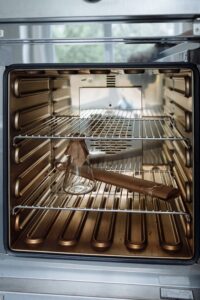A properly functioning refrigerator is essential for keeping food fresh and safe to consume. It is responsible for maintaining the ideal temperature to prevent the growth of bacteria and other microorganisms that can cause foodborne illnesses. However, there are times when a refrigerator may not be cooling properly, which can lead to spoiled food and potential health risks. In this article, we will discuss the signs that indicate a refrigerator is not cooling properly and explore the common causes of cooling issues. We will also provide tips on how to troubleshoot and address these problems to ensure your refrigerator is working efficiently.
Key Takeaways
-
Signs of a refrigerator not cooling properly include warm temperatures inside, spoiled food, and frost buildup.
-
Common causes of cooling issues include dirty coils, faulty thermostats, and malfunctioning compressors.
-
Checking the thermostat and temperature controls can help identify if they are set correctly and functioning properly.
-
Inspecting the condenser coils for dirt and debris can improve the refrigerator’s cooling efficiency.
-
Cleaning the refrigerator’s air vents can also improve airflow and cooling performance.
-
Checking the refrigerator’s door seals for cracks or gaps can prevent warm air from entering the fridge.
-
Assessing the evaporator fan can help identify if it’s working correctly and circulating cold air.
-
Evaluating the compressor can help determine if it’s functioning properly and not overheating.
-
Addressing refrigerant leaks is crucial for proper cooling and should be handled by a professional.
-
Call a professional for refrigerator repairs if the issue persists or if there are any electrical or mechanical problems.
Signs of a Refrigerator Not Cooling Properly
There are several signs that indicate a refrigerator is not cooling properly. One of the most obvious signs is when the temperature inside the refrigerator is higher than it should be. You may notice that your food is not staying as cold as it used to or that items are spoiling more quickly. Another sign is if you hear your refrigerator running constantly or if it is making unusual noises. This could indicate that the compressor is working overtime to try to cool the refrigerator.
When a refrigerator is not cooling properly, it can have serious implications for the quality and safety of your food. Bacteria thrive in warm temperatures, so if your refrigerator is not cold enough, it can lead to the rapid growth of harmful bacteria on your food. This can increase the risk of foodborne illnesses such as salmonella or E. coli. Additionally, spoiled food can be a waste of money and resources, as you will need to throw away any items that have gone bad.
Common Causes of Refrigerator Cooling Issues
There are several common causes of refrigerator cooling issues. One possible cause is a malfunctioning thermostat or temperature control. If these components are not working properly, they may not be accurately sensing and regulating the temperature inside the refrigerator. Another common cause is dirty or clogged condenser coils. These coils are responsible for dissipating heat from the refrigerator, and if they are covered in dust or debris, they cannot effectively cool the refrigerator.
Other potential causes of cooling issues include blocked air vents, faulty door seals, a malfunctioning evaporator fan, or a failing compressor. Blocked air vents can prevent the proper circulation of cold air throughout the refrigerator, while faulty door seals can allow warm air to enter the refrigerator and cold air to escape. A malfunctioning evaporator fan may not be circulating the cold air properly, and a failing compressor may not be able to compress the refrigerant effectively.
Checking the Thermostat and Temperature Controls
To check the thermostat and temperature controls, start by locating them inside your refrigerator. They are usually located near the top or back of the refrigerator compartment. Once you have located them, make sure they are set to the desired temperature. If they are set correctly but you suspect they may be malfunctioning, you can try resetting them by turning them off and then back on again.
It is important to set the thermostat and temperature controls to the proper temperature for optimal cooling performance. The ideal temperature for a refrigerator is between 35 and 38 degrees Fahrenheit (1.7 to 3.3 degrees Celsius). Setting it too low can cause freezing in some areas of the refrigerator, while setting it too high can lead to inadequate cooling.
Inspecting the Condenser Coils
To inspect the condenser coils, you will need to locate them on your refrigerator. They are typically located either on the back of the refrigerator or underneath it behind a removable panel. Once you have located them, visually inspect them for any signs of dirt, dust, or debris. If they appear dirty, you will need to clean them.
Clean condenser coils are essential for proper cooling performance because they help dissipate heat from the refrigerator. When they are covered in dirt or debris, they cannot effectively release the heat, which can lead to inadequate cooling. To clean the condenser coils, you can use a vacuum cleaner with a brush attachment or a coil cleaning brush. Gently brush away any dirt or debris, being careful not to damage the coils.
Cleaning the Refrigerator’s Air Vents
To clean the refrigerator’s air vents, start by locating them inside the refrigerator. They are usually located at the back of the refrigerator compartment or on the sides. Once you have located them, visually inspect them for any signs of dirt or blockage. If they appear dirty or blocked, you will need to clean them.
Clean air vents are important for proper cooling performance because they allow for the circulation of cold air throughout the refrigerator. When they are blocked or clogged, cold air cannot flow freely, which can lead to uneven cooling or inadequate cooling in certain areas of the refrigerator. To clean the air vents, you can use a soft brush or a vacuum cleaner with a brush attachment. Gently brush away any dirt or debris, being careful not to damage the vents.
Checking the Refrigerator’s Door Seals
To check the refrigerator’s door seals, start by visually inspecting them for any signs of wear or damage. Look for cracks, tears, or gaps in the seals. Next, perform a simple test to check their effectiveness. Close the refrigerator door on a piece of paper or dollar bill so that it is partially sticking out. Try to pull out the paper or bill. If it comes out easily, it may indicate that the door seals are not sealing properly.
Proper door seals are crucial for proper cooling performance because they prevent warm air from entering the refrigerator and cold air from escaping. When the door seals are damaged or not sealing properly, warm air can enter the refrigerator and cause it to work harder to maintain its temperature. This can lead to inadequate cooling and increased energy consumption.
Assessing the Refrigerator’s Evaporator Fan
To assess the refrigerator’s evaporator fan, start by locating it inside the refrigerator. It is usually located at the back of the freezer compartment. Once you have located it, listen for any unusual noises coming from the fan. If it is making loud or grinding noises, it may indicate that the fan is malfunctioning and needs to be replaced.
A properly functioning evaporator fan is important for proper cooling performance because it circulates the cold air throughout the refrigerator. When the fan is not working properly, cold air cannot be distributed evenly, which can lead to inadequate cooling in certain areas of the refrigerator. This can result in food spoilage and an increased risk of foodborne illnesses.
Evaluating the Refrigerator’s Compressor
To evaluate the refrigerator’s compressor, start by listening for any unusual noises coming from it. If you hear clicking or buzzing sounds, it may indicate that the compressor is failing and needs to be replaced. You can also check if the compressor is running by placing your hand on it and feeling for vibrations. If you do not feel any vibrations, it may indicate that the compressor is not working.
A properly functioning compressor is essential for proper cooling performance because it compresses the refrigerant and circulates it through the refrigeration system. When the compressor is not working properly, it cannot effectively compress the refrigerant, which can lead to inadequate cooling. This can result in spoiled food and potential health risks.
Addressing Refrigerant Leaks
If you suspect a refrigerant leak in your refrigerator, it is best to call a professional for repairs. Refrigerant leaks can be dangerous and should only be handled by trained technicians. They have the knowledge and equipment to safely diagnose and repair refrigerant leaks.
Proper refrigerant levels are crucial for proper cooling performance because refrigerant is responsible for absorbing heat from inside the refrigerator and releasing it outside. When there is a refrigerant leak, the refrigerator cannot effectively cool the interior, which can lead to inadequate cooling. It is important to address refrigerant leaks promptly to prevent further damage to the refrigerator and ensure its proper functioning.
When to Call a Professional for Refrigerator Repairs
While some refrigerator cooling issues can be addressed by homeowners, there are times when it is appropriate to call a professional for repairs. If you have tried troubleshooting the problem and it persists, or if you are unsure about how to proceed, it is best to seek professional help. A trained technician will have the knowledge and experience to diagnose and repair complex issues.
Hiring a professional for refrigerator repairs has several benefits. They have access to specialized tools and equipment that may not be available to homeowners. They also have the expertise to accurately diagnose and repair the problem, which can save you time and money in the long run. Additionally, professional repairs often come with warranties or guarantees, providing you with peace of mind.
A properly functioning refrigerator is essential for keeping food fresh and safe to consume. If you suspect that your refrigerator is not cooling properly, it is important to take action promptly. By recognizing the signs of cooling issues and addressing them accordingly, you can ensure that your refrigerator is working efficiently and effectively. Remember to check the thermostat and temperature controls, inspect the condenser coils, clean the air vents, check the door seals, assess the evaporator fan, evaluate the compressor, and address refrigerant leaks if necessary. If you are unsure about how to proceed or if the problem persists, do not hesitate to call a professional for repairs. Your health and safety depend on it.
If you’re experiencing issues with your refrigerator not cooling properly, it’s important to identify and fix the problem as soon as possible. One helpful resource is the blog section of 911 Appliance Repair’s website. In their article titled “Refrigerator Not Cooling Properly: Identifying and Fixing Issues,” they provide valuable insights and tips on troubleshooting common problems that can cause a refrigerator to lose its cooling efficiency. From checking the condenser coils to examining the door seals, this article offers practical advice to help you diagnose and resolve the issue. To learn more, visit https://911Appliance.com/our-blog/.
Can a Faulty Heating Element Affect the Cooling of a Refrigerator?
Yes, a faulty heating element can affect the cooling of a refrigerator. Identifying heating element temperature issues is crucial in maintaining the proper functioning of the appliance. If the heating element is not working properly, it can lead to an imbalance in temperature regulation, ultimately impacting the refrigerator’s cooling capabilities.
FAQs
What are the common reasons why a refrigerator is not cooling properly?
Some common reasons why a refrigerator is not cooling properly include a dirty condenser coil, a malfunctioning thermostat, a faulty compressor, a blocked air vent, and a refrigerant leak. In addition to these issues, users may also experience problems with the door seals, which can lead to warm air entering the fridge and causing temperature fluctuations. When troubleshooting whirlpool fridge common issues, it is essential to check these seals for any tears or gaps. Regular maintenance, like cleaning the condenser coils and ensuring proper airflow, can also help prevent these problems from occurring. Additionally, users should be aware that the placement of the refrigerator can impact its cooling efficiency; it should not be crammed into a tight space that obstructs air circulation. When troubleshooting common refrigerator issues, it’s beneficial to disconnect the power and give the appliance some time to reset, which can resolve minor electronic glitches. Taking proactive steps, such as ensuring the refrigerator is level and away from heat sources, can also contribute to its optimal performance.
How can I identify the issue with my refrigerator?
You can identify the issue with your refrigerator by checking the temperature settings, inspecting the condenser coil, checking the air vents, and listening for unusual noises. You may also need to use a multimeter to test the electrical components. In addition to these steps, it’s crucial to ensure that the refrigerator is properly leveled, as an uneven surface can affect its performance. When troubleshooting common refrigerator issues, consider checking the door seals for any gaps or damage that may be causing temperature fluctuations. If the problem persists, consulting the user manual or contacting a professional may provide further insights into the underlying cause.
What should I do if my refrigerator is not cooling properly?
If your refrigerator is not cooling properly, you should first check the temperature settings and make sure they are set correctly. You should also clean the condenser coil, check the air vents, and listen for unusual noises. If these steps do not solve the problem, you may need to call a professional technician to diagnose and fix the issue.
Can I fix my refrigerator myself?
Some issues with a refrigerator can be fixed by the owner, such as cleaning the condenser coil or replacing a faulty thermostat. However, more complex issues such as a refrigerant leak or a faulty compressor should be handled by a professional technician. Additionally, if the refrigerator is not running at all, owners can begin with basic troubleshooting steps, such as checking the power supply and ensuring that the unit is plugged in properly. For more extensive problems, like troubleshooting refrigerator not running, it’s advisable to consult the user manual or contact a qualified technician to avoid further damage. Regular maintenance can help minimize these issues and prolong the lifespan of the appliance.
How often should I clean the condenser coil?
The condenser coil should be cleaned at least once a year to ensure proper cooling and efficiency. However, if you have pets or live in a dusty environment, you may need to clean it more frequently.
What should I do if there is a refrigerant leak?
If there is a refrigerant leak, you should immediately turn off the refrigerator and call a professional technician. Refrigerant is harmful to the environment and can cause health problems if inhaled. A professional technician will be able to safely repair the leak and recharge the refrigerant.



